#Museum of American Woman
Text
Why don’t the TQ+ just fundraise for their own museum?
The Smithsonian’s new Museum of American Women has announced it will be featuring at least one trans-identified male in the name of “inclusivity.” Monica Helms, the designer of the trans pride flag, will be inducted in the yet-to-be-opened facility despite concerning past behavior.
The Smithsonian first announced its new woman-centered museum last year when it inked a deal in the SoHo neighborhood of New York City. Despite the fact it does not estimate the physical building will be opened to the public for at least 10 years, announcements about the design, facilities, and curation of the museum have already begun.
On the Smithsonian’s website, women are being featured whose exhibits and information will assumedly be present in the physical museum. Among them are prominent figures who changed the course of American and world history, including Henrietta Lacks — an African American woman whose “immortal” cell line has provided invaluable medical data since the 1950s — and Native American veteran and activist Grace Thorpe.
But among the brave and inspirational female leaders will be some males who identify as “women.”
In 2022, museum founder Abby Trott said she had brought in a team “of amazing, talented women” to design the upcoming exhibits, stating: “We’re trying to create a space to allow women — and anyone who identifies as a woman — to have a physical space to bond and be seen and heard and have a space to define what it means for them to be a woman.”
Among those males included in the Women’s Museum will be Monica Helms, the designer of the trans pride flag.

Born Robert Hogge, Helms designed the first trans pride flag in 1999. In his memoir, More Than Just a Flag, Helms – who named himself after a fictional battle in Tolkien’s The Lord of the Rings – described himself as an “enlightened” being who is able to “float” between multiple worlds.
As previously reported by Reduxx, Helms once admitted to wearing his mother’s underwear as a youth, and stated that he “studied” girls at his school with an obsession that slowly turned to “lust.”
While serving with the US Navy during the 1970s, Helms began stealing the undergarments of female neighbors living in his apartment complex in South Carolina after seeing a bra in the washing machine of the laundry room.

“Images of the days when I tried on my mother’s underwear came back to me, pulling primordial feelings with them… the obsession of losing my virginity had filled my every waking moment…” Helms said of the experience. “Up until this point, my sexual desire for a first encounter had pushed every other fantasy of mine onto the back burner. As I stood watching the bra swirl around in the dryer, I sensed a growing desire to dress as a woman and to see the hidden woman within me.”
Helms then described taking the bra out of the machine and rushing back to his apartment to model it for himself in the mirror. He expressed having been sexually aroused at the sight of himself in women’s undergarments.
Helms later married a woman who would discover his crossdressing fetish after walking in on him wearing one of her dresses. While she disapproved, Helms would continue regardless, and began spending family finances on clothing, makeup, and hormones. He also invested in attending get-togethers, with other male cross-dressers, where lessons were provided on how to talk and walk “like a woman.”
While Helms’ was indulging his expensive crossdressing habit, the family declared bankruptcy and lost their home in foreclosure.
After decades of marriage, Helms decided to divorce his wife and leave his children so he could pursue his life as a trans-identified male.
“They didn’t want me to leave, which made me feel even worse. But I couldn’t continue hiding my doctor visits and medical costs, not to mention receiving hateful comments from Donna about my shaved legs and breast growth,” Helms wrote in his autobiography.
But perhaps most disturbingly, Helms has authored several short stories with sexual themes, including ‘forced feminization,’ wherein men are transformed into women as a humiliating punishment. One story in particular sexualizes a little girl, with Helms claiming the story concept came to him in a dream. In the story, titled “A Woman Scorned,” a witch who perpetually appears as a teen girl pursues an adult man until they get married and have a daughter with similar “powers.”
Earlier this year at the age of 71, Helms announced he was adopting a teen boy with his significantly younger partner. The 14-year-old will be raised as his “trans daughter.”
Helms designed what is currently understood as the transgender pride flag in 1999, just a few years after divorcing his wife and ostensibly abandoning his children. During an interview held in 2017, Helms stated that blue represented young boys and pink represented young girls.
He has claimed the baby blue and pink pastel stripes came to him by way of “divine intervention.” A pride flag created by Helms will be displayed in the Smithsonian’s new Museum of American Women.
In 2014, the Smithsonian’s National Museum of American History accepted Helms’ original pride flag and placed it in the permanent archives.
By Anna Slatz
Anna is the Co-Founder and Editor-in-Chief at Reduxx, with a journalistic focus on covering crime, child predators, and women's rights. She lives in Canada, enjoys Opera, and kvetches in her spare time.
Will his exhibit feature the underwear he stole? It’s not like any of the women he stole them from would want them back.
8 notes
·
View notes
Text

Frank Weston Benson (1862-1951)
"Summer" (1890)
Oil on canvas
Impressionism
Located in the Smithsonian American Art Museum, Washington DC, United States
#paintings#art#artwork#allegorical painting#summer#frank weston benson#oil on canvas#fine art#american impressionism#impressionism#smithsonian american art museum#museum#art gallery#american artist#female portrait#portrait of a woman#allegory#purple#white dress#dresses#clothing#clothes#1890s#late 1800s#late 19th century
789 notes
·
View notes
Text


Mary Cassat (American, 1844-1926) • Portrait of the Artist (self-portrait) • 1878 • Metropolitan Museum of Art, New York City
#art#art history#self portrait#painting#oil painting#mary cassatt#woman artist#american artist#19th century art#impressionism#metropolitan museum#the canvas mirror art blog#artist as subject#art blogs on tumblr#art lovers on tumblr#artwork
58 notes
·
View notes
Text

C.C. Lamberg-Karlovsky - Excavations at Tepe Yahya, Iran, 1967-1969 - ASPR/AIPU - 1970
#witches#neolithics#occult#vintage#excavations at tepe yahya#tepe yahya#excavations#american school of prehistoric research#the asia institute of pahlavi university#peabody museum#harvard university#pahlavi university#shiraz university#c.c. lamberg-karlovsky#iran#persia#archaeology#report 1#bullettin 27#woman#slim#1967-1969#1970#beauty
33 notes
·
View notes
Text

Lucille Blanche (American, 1895–1981) • Flowers • 1927 • Whitney Museum of American Art, New York City
#art#still life#painting#fine art#art history#woman artist#american artist#whitney museum#lucille blanche
28 notes
·
View notes
Text
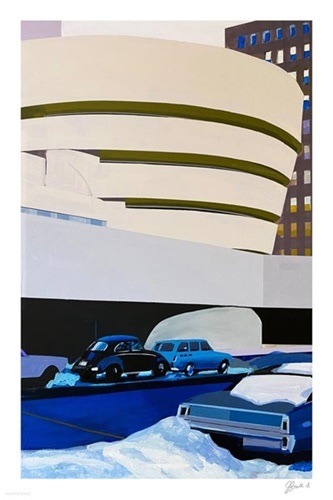
Jessica Brilli
Guggenheim
#jessica brilli#american artist#american painting#american painter#american art#american realism#woman artist#woman painter#guggenheim#guggenheim museum#frank lloyd wright#contemporary art#modern art#art history#aesthetictumblr#tumblraesthetic#tumblrpic#tumblrpictures#tumblr art#aesthetic#beauty
27 notes
·
View notes
Text

#happybirthday #amyadams #actress #loislane #manofsteel #batmanvssuperman #ZackSnydersJusticeLeague #arrival #DearEvanHansen #enchanted #Disenchanted #TheWomanintheWindow #HillbillyElegy #americanhustle #themaster #sharpobjects #nocturnalanimals #themuppets #nightatthemuseum
#happybirthday#amy adams#actress#lois lane#man of steel#batman v superman#zacksnydersjusticeleague#arrival#dear evan hansen#enchanted#disenchanted#the woman in the window#hillbilly elegy#american hustle#the master#sharp objects#nocturnal animals#the muppets#night at the museum
10 notes
·
View notes
Text
#TurtleTuesday:

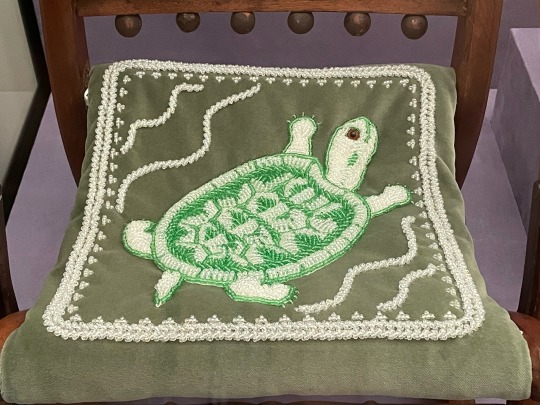

“Sky Woman (she/her)” by Karen Ann Hoffman (Oneida)
Wood, velvet, glass beads, Czechoslovakian crystals, cotton thread, sterling silver beads
“Adopted from the artist and living with the Field Museum in 2018”
from the Field Museum’s Native Truths: Our Stories, Our Voices exhibition
#native american art#first nations art#indigenous art#contemporary art#2010s#oneida#Karen Ann Hoffmann#turtle#Sky Woman#Field Museum#Native Truths: Our Stories Our Voices#exhibition#museum visit#turtle tuesday#animals in art
95 notes
·
View notes
Text

Agnes Felton (German-American 1881-1961, lived and worked in Cathedral City, CA), Light Center, 1961. (Source: Whitney Museum of American Art, New York)
#art#artwork#modern art#contemporary art#modern artwork#contemporary artwork#20th century art#modern 20th century art#contemporary 2oth century art#American art#modern American art#contemporary American art#American artist#female American artist#female artist#woman artist#Californian art#Californian artist#Agnes Felton#Whitney Museum of American Art#symbolism#desert transcendentalist
12 notes
·
View notes
Text
The Women of World War I — Part I
Before The Great War, working class women were not new to factory work. There was, however, a division between women's and men's jobs. After war was declared, women increasingly took on the men's jobs to fill the gap left when men were recruited as soldiers. With munitions factories producing for the war effort, there were even more jobs for women to fill – many of them dangerous and requiring significant physical strength.
While the fashion plates were still catering to the well-to-do, the war did influence women's fashion in consequential and lasting ways.
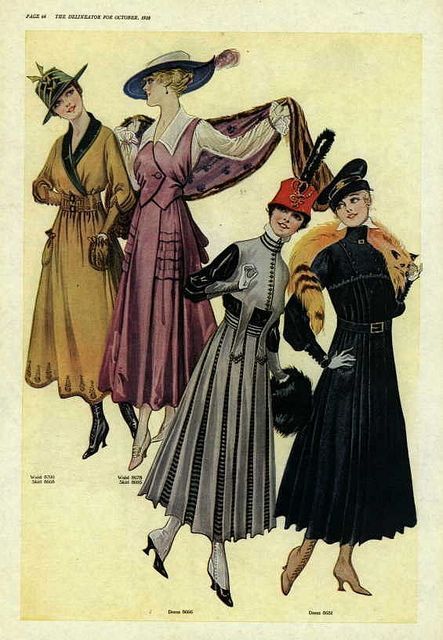
Clothing became more sensible. Gone were the restricting undergarments of past eras. Clothing was more tailored and most significantly, hemlines rose to several inches above the ankle.
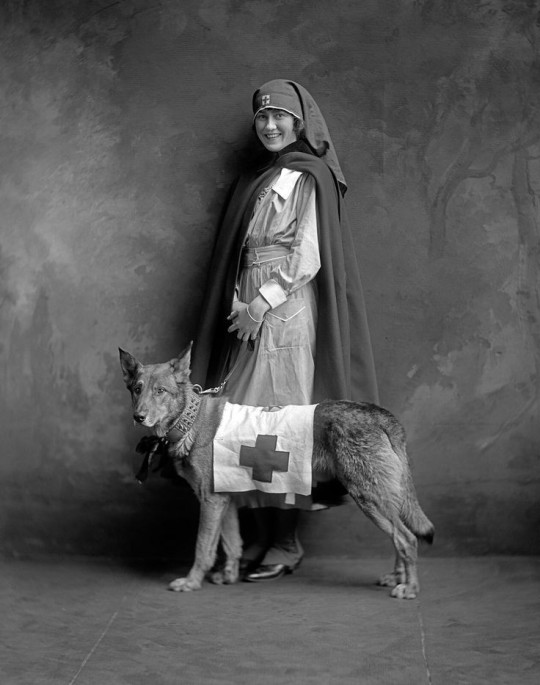
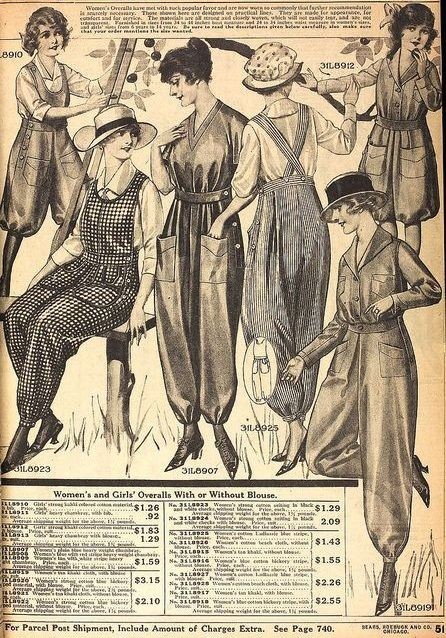
In Britain women joined the Voluntary Aid Detachment and Queen Alexandra’s Royal Army Nursing Corps. In the USA, the Marine Corps Women’s Reserve, and the special women’s battalions on the Russian Front.
In rural areas women were called to duty to perform an assortment of farm work and chores that had been previously done by the men who went to war. In the image on the right, a catalog page displays styles of overalls and briches particularly suited to outdoor work.
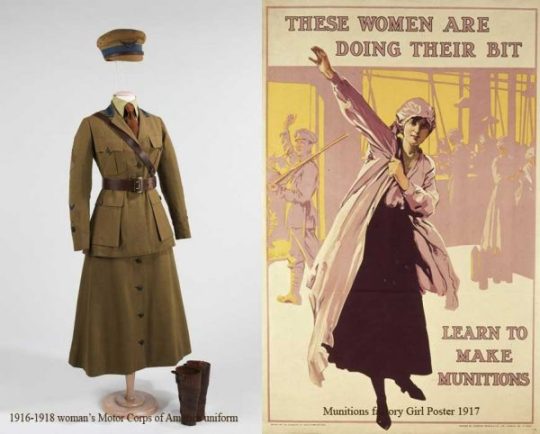
Above are two very different roles that women took during WW I. The Women's Motor Corps of the American Red Cross was largely made up of wealthy women who had the means of access to an automobile and learned to drive. The munitions factory girls on the other hand, worked at physically demanding, dangerous work and likely came from modest means. The latter were called "Canary Girls" because the exposure to TNT caused a yellowing of the skin. They faced not only safety but als9 health hazards, for very low wages.



Flora Lion (British/English, 1878-1958) • Women's Canteen at Phoenix Works, Bradford, England • 1918
Flora Lion, an established society portrait artist, was commissioned by the Ministry of Information to complete two large paintings showing factory scenes during the First World War.
Stay tuned for Part II...
Sources: French History Podcast, Imperial War Museum, Wikipedia, American Red Cross, BBC.com
#fashion history#women's history#ww 1 history#canary girls#history of workers#1910s photography#american red cross#imperial war museum#the resplendent outfit blog#flora lion#woman artist#war artist
3 notes
·
View notes
Text

Taylor Russell x Alexa Demie
at Academy Museum Gala (2022)
#taylor russell#alexa demie#american museum gala#academy museum gala#black girl magic#woman of color#beauty#black beauty#biracial#person of color#pro-royalty
64 notes
·
View notes
Text

Frederick Carl Frieseke (1874-1939)
"Reflection (Marcelle)"
Oil on canvas
Located in the Telfair Museum, Savannah, Georgia, United States
#paintings#art#artwork#genre painting#female portrait#frederick carl frieseke#oil on canvas#fine art#telfair museum#museum#art gallery#american artist#portrait of a woman#female figure#red hair#blue#a queue work of art
964 notes
·
View notes
Photo

#justin timberlake#met gala#red carpet#2010#the costume institute gala#american woman: fashioning a national identity#metropolitan museum of art#timberlake#suit and tie#jt
15 notes
·
View notes
Text

Me with a fair amount of my original characters like...
#🌠#Meme Post#I’ve got a middle-aged museum archivist with a large nose and bony bumps on his shoulders...#... a plus-sized freckled woman with two front teeth missing who’s a gifted multi-instrumentalist...#... a plus-sized bald British immigrant man with a golden singing voice and a golden heart to match...#... an Ethiopian Jewish immigrant woman with the most friendly gap-toothed smile one could ever witness...#... a balding middle-aged bookstore owner with a bowtie for every occasion and a fondness for Shakespeare and movies based on books...#... a short yet chill African American punk dude with a mohawk as astounding as his bass-playing talents...#... a very tall and very lanky awkward beach bum dude with a slight potbelly and loads of anxiety...#... a muscular sporty woman who was the star player in her high school’s football team...#... and a tall husky Lift Bridge operator with a full head of silver hair and a noticeable belly due to age and his love of sweets.#Sure I also have characters that are “conventionally” attractive as well - nothing wrong with a little aesthetic appeal here and there.#But the fact of the matter is I’m here to make characters that are true to life - people that folks can actually see existing...#... in a world as vast and assorted as ours. I’m not here to write a YA novel. If you can’t vibe with that we can’t be friends.✌
30 notes
·
View notes
Text

Mother and Son
Artist: Thomas Sully (American, 1783–1872)
Genre: Portrait
Depicted People: Jane Cooper Sully Darley, Francis Darley
Date: 1840
Medium: Oil on Canvas
Collection: Metropolitan Museum of Art
This grand, allegorically rich portrait of Sully's daughter Jane Cooper Sully Darley (1807-1877) and her son Francis Thomas Sully Darley (d.1914) has provoked many interpretations, the most ambitious of which equates mother and son with the mythological figure of Penelope, the ideal wife of Odysseus, and Telemachus, her perfect son. Sully filled the composition with attributes of blithe family life: the spray of ivy clinging to the wall is the emblem of a faithful wife; the scene on the urn--Hermes bringing the infant Dionysus to be nurtured by the nymphs--alludes to the duties of motherhood; the boy's foot lightly resting on his dog connotes fidelity and loyalty.
#portrait#oil on canvas#thomas sully#american art#american culture#woman#young boy#19th century art#metropolitan museum of art#jane cooper sully darley#francis darley
1 note
·
View note
Text



The metropolitan museum of New York. 🗽
#bionicle#the bionic woman#bionic commando#super sonic#magicrealism#magica de spell#magic moments#monkey magic#magical#magick#magia#magia blanca#belleza#que belleza!!#belleza femenina#beauty#beautiful model#the metropolitan museum of art#the met gala#met gala#metmuseum#met museum#museum collections#american museum of natural history#art museum#fine art#modern art#art deco#artistic#arte
0 notes